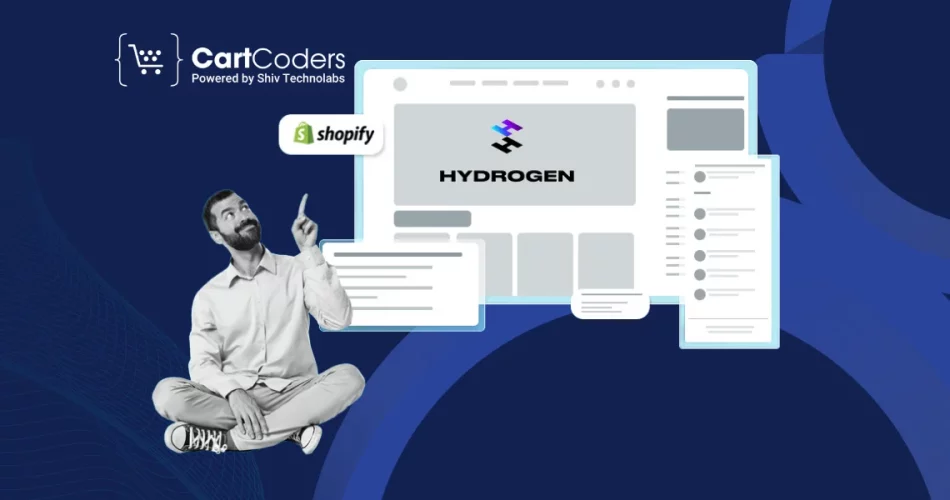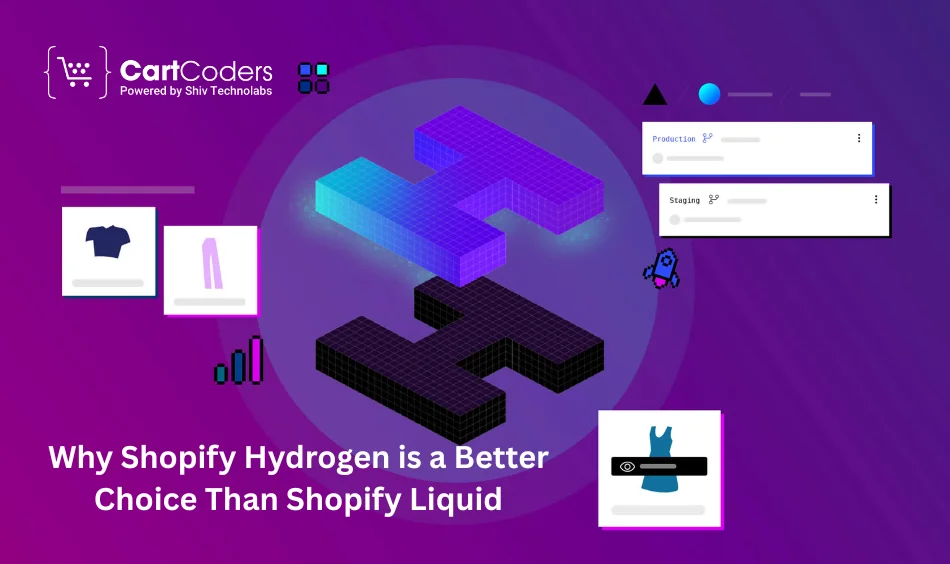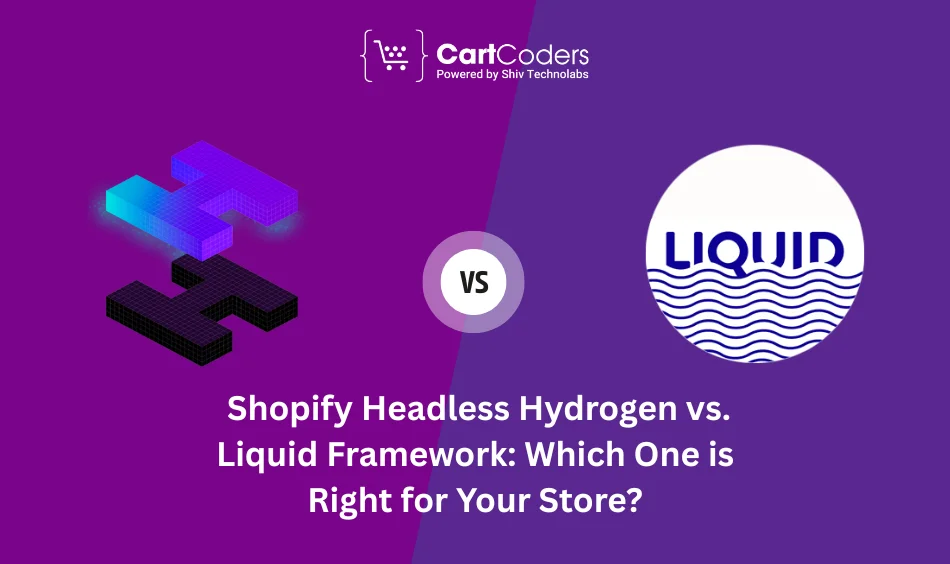Custom Engagement Solutions
Unlock tailored solutions with a free, no-obligation strategy session.
Expert Developers & Engineers on Demand
Scale Your Team with Skilled IT Professionals
Expert Guidance for Digital Transformation

Shopify has become a leading choice for online businesses due to its ease of use and powerful features. Traditionally, Shopify stores have relied on Shopify Liquid, a templating language that powers Shopify themes. While the Liquid Framework is widely used, it comes with limitations in terms of flexibility and performance.
As the demand for faster and more customized storefronts grows, Shopify Hydrogen has emerged as an alternative. This React Framework allows businesses to create a Headless Shopify setup, giving them more control over their online store’s design and functionality.
Here in this article, we compare the Shopify liquid framework and hydrogen to highlight the key differences and why headless shopify hydrogen gained traction.
Shopify Headless Hydrogen is a React-based framework designed to help businesses build custom storefronts using a headless commerce approach. Unlike traditional Shopify themes that rely on Shopify Liquid, Hydrogen allows merchants to separate the front end from the back end, giving them complete control over their store’s design, performance, and functionality.
With Hydrogen, developers can create a highly interactive and fast-loading Shopify Hydrogen eCommerce store that connects directly to Shopify’s backend via APIs. This framework is tailored for businesses that want unique shopping experiences beyond the limitations of pre-built Shopify themes.
Shopify Hydrogen is built on a React framework, which means it allows developers to create dynamic, fast, and engaging storefronts. It works in a headless setup, where the front end (storefront) is decoupled from the back end (Shopify’s core system).
Here’s how Shopify Hydrogen operates:
Also Read: 12 Tips for Shopify Hydrogen Headless Commerce Development
Shopify Liquid is a templating language used to build Shopify themes. It works within Shopify’s ecosystem, allowing merchants to customize their storefronts without needing deep coding knowledge. The Liquid Framework handles data dynamically, making it easier to create engaging store experiences.
However, since Liquid operates within predefined Shopify structures, customization remains limited. Store owners can adjust existing Shopify themes, but they lack complete control over design and performance.

Businesses using Shopify Liquid often face limitations in speed, customization, and scalability. Shopify Hydrogen, built with a React framework, provides a modern alternative for merchants looking for greater control over their store’s design and performance. Here are the key reasons why Shopify Hydrogen eCommerce store development is a strong choice over Liquid-based themes.
Speed plays a crucial role in customer experience and sales. Shopify Liquid relies on Shopify’s built-in rendering system, which can slow down page load times, especially for stores with high traffic or dynamic content.
Shopify Liquid operates within a pre-defined template system, restricting deep customization. While merchants can edit Liquid themes, complex modifications require workarounds.
A Shopify Headless Hydrogen vs. Liquid Framework comparison shows that Shopify Liquid is tied to Shopify’s built-in theme engine, limiting how businesses structure their storefronts.
Stores using Shopify Liquid depend on Shopify’s hosting, which may not handle high traffic efficiently. As businesses scale, they need a more flexible solution.
Developers working with Shopify Liquid need to follow Shopify’s specific coding structure, which limits access to modern development tools.
Customization is key in eCommerce, but Shopify Liquid themes make it difficult to offer tailored shopping experiences.
Why Hydrogen is Better:
For businesses requiring a fast, scalable, and fully customizable storefront, Shopify Hydrogen offers clear advantages over Shopify Liquid. While Liquid works well for smaller stores that rely on Shopify’s built-in tools, Hydrogen is a better choice for brands wanting headless commerce capabilities and greater flexibility.

Businesses using Shopify Liquid often encounter limitations in customization, speed, and scalability. Shopify Hydrogen offers a modern alternative with headless capabilities, allowing merchants to build fast and customized storefronts. Below is a comparison to help you decide whether to switch to the Shopify Hydrogen framework or continue using Shopify Liquid.
| Feature | Shopify Liquid | Shopify Hydrogen |
| Technology Stack | Uses Liquid Framework, Shopify’s proprietary templating language. | Built on React Framework, enabling headless commerce. |
| Customization | Limited by Shopify themes and predefined templates. | Complete control over storefront design and functionality. |
| Performance | Server-side rendering can slow down page load times. | Uses server-side rendering (SSR) for faster loading speeds. |
| Scalability | Works within Shopify’s hosting environment with some performance limitations. | Can be hosted externally, offering better scalability for large businesses. |
| Developer Experience | Requires Shopify-specific knowledge and is less flexible. | Uses modern tools like React, GraphQL, and REST APIs, making development easier. |
| Integration Capabilities | Limited third-party integrations; rely on Shopify’s built-in ecosystem. | Connects with various third-party tools and services via APIs. |
| Mobile Optimization | Works well with Shopify’s built-in mobile-responsive themes. | Fully customizable for mobile-first and progressive web app (PWA) experiences. |
| Dynamic Content | Static content with fewer real-time updates. | Supports real-time updates and dynamic content rendering. |
| Personalization | Limited personalization options without additional apps. | Advanced customer experience customization with interactive elements. |
| Best For | Small to medium-sized businesses looking for an easy-to-use, template-based store. | Businesses require a high-performance, custom, and scalable storefront. |
| Maintenance & Hosting | Managed by Shopify; requires less technical maintenance. | Requires external hosting and ongoing maintenance for performance optimization. |
| SEO Performance | Standard SEO options are available within Shopify’s framework. | Advanced SEO control with faster page speeds and structured data. |
Businesses looking for custom storefronts and better performance often shift to Shopify Headless Hydrogen. Here are some cases where Hydrogen works best:
Not every business needs Headless Shopify. Some stores may find Shopify Liquid more suitable in these cases:
The choice between Shopify Liquid and Hydrogen depends on business goals. For a simple setup, Liquid works well. For advanced customization, Hydrogen is the better option.
The demand for Shopify Hydrogen theme development is expected to grow as businesses shift toward headless commerce. Shopify has already invested in Hydrogen Framework, showing its commitment to modernizing eCommerce development.
Also Read: Building Custom Storefronts with Shopify Hydrogen
CartCoder specializes in Shopify to Shopify Headless Hydrogen migration services, helping businesses build next-generation eCommerce stores that deliver exceptional user experiences.
At CartCoder, we understand the growing need for headless commerce. Our expert team provides end-to-end Shopify Hydrogen development, ensuring your store is:
If you’re ready to take your Shopify store to the next level with Shopify Hydrogen, CartCoder is here to help. Our expert team ensures a smooth and hassle-free transition to headless Shopify, giving you a competitive edge in the eCommerce space.
Choosing between Shopify Liquid and Hydrogen depends on your business needs. While Shopify Liquid is ideal for standard Shopify stores, Shopify Hydrogen offers greater performance, flexibility, and scalability for brands looking to create a unique and high-speed shopping experience.
For businesses planning long-term growth, migrating from Shopify Liquid to Hydrogen framework can provide significant advantages, including faster load times, custom storefronts, and seamless third-party integrations. With Shopify’s continuous investment in the Hydrogen framework, the future of eCommerce is shifting toward headless commerce.
At CartCoder, we specialize in migrating your existing Shopify store to a headless setup, ensuring a smooth transition from Liquid to Hydrogen. Whether you’re upgrading your existing store or building a custom Shopify Hydrogen store from scratch, our expert team will handle the entire process with precision and efficiency.
Looking to switch to Shopify Hydrogen? Contact CartCoder today and build a high-performance, scalable, and fully customized storefront with our Shopify headless commerce solutions!
Projects delivered in 15+ industries.
95% retention rate, building lasting partnerships.
Serving clients across 25+ countries.
60+ pros | 10+ years of experience.